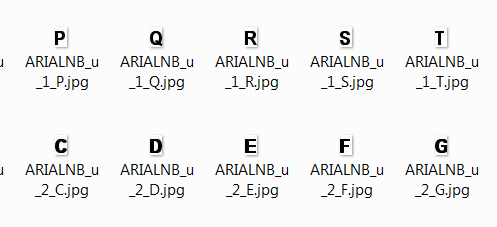For OCR (optical character recognition) task, single character text images are used to train the machine-learning model. These single character images ranges from hand written text dataset to synthetic text dataset generated using script. Synthetic text dataset is faster way to generate training examples in large quantity. Also, for some applications (e.g. scanning printer generated document), synthetic text dataset may be sufficient.
I have written following python script to generate this dataset. Script tries to generate 12×20 size images of a-z, A-Z and 0-9 character for selected fonts. For the application of my interest, I only need regular English fonts, so I created fonts list in text file (Fonts_list.txt). I get all fonts in my system (for windows it is usually C:\Windows\Fonts\*.ttf) and select only fonts which are listed in Fonts_list.txt. If dataset for all available system-fonts needs to be generated, then script needs to be modified accordingly. Also, instead of getting all fonts from C:\Windows\Fonts\*.ttf, we can use ttfquery module (ttfquery.findsystem.findFonts()).
For selected font, script will generate each of above character (a-z, A-Z, 0-9) at nine different position to move text by one pixel in right-left and top-bottom direction. Generated image follows following terminology:
<font>_<l_u_d_flag>_<position_0_9>_<character>.jpg
Example: arialbd_u_3_H.jpg
I had to use l_u_d_flag to differentiate between image for ‘h’ and ‘H’, otherwise later image used to overwrite the previous one.
Using this terminology will be useful to decide target class, when these images are used for training the machine-learning model.
Calibri Times Arial Aparaj Agency Bell Brln Bod_ Book CALIST Cambria Candara Century Consola Constan Corbel DokChamp Elephnt Euphemia FRAD FRAH FRAMD FRAB Gadugi Gara Georgia Impact MS Poor Verdana
Script:
<pre>from PIL import Image, ImageDraw, ImageFont
import ttfquery.findsystem
import string
import ntpath
import numpy as np
import os
import glob
fontSize = 20
imgSize = (12,20)
position = (0,0)
#All images will be stored in 'Synthetic_dataset' directory under current directory
dataset_path = os.path.join (os.getcwd(), 'Synthetic_dataset')
if not os.path.exists(dataset_path):
os.makedirs(dataset_path)
fhandle = open('Fonts_list.txt', 'r')
lower_case_list = list(string.ascii_lowercase)
upper_case_list = list(string.ascii_uppercase)
digits = range(0,10)
digits_list=[]
for d in digits:
digits_list.append(str(d))
all_char_list = lower_case_list + upper_case_list + digits_list
fonts_list = []
for line in fhandle:
fonts_list.append(line.rstrip('\n'))
total_fonts = len(fonts_list)
#paths = ttfquery.findsystem.findFonts()
all_fonts = glob.glob("C:\\Windows\\Fonts\\*.ttf")
f_flag = np.zeros(total_fonts)
for sys_font in all_fonts:
#print "Checking "+p
font_file = ntpath.basename(sys_font)
font_file = font_file.rsplit('.')
font_file = font_file[0]
f_idx = 0
for font in fonts_list:
f_lower = font.lower()
s_lower = sys_font.lower()
#Check desired font
if f_lower in s_lower:
path = sys_font
font = ImageFont.truetype(path, fontSize)
f_flag[f_idx] = 1
for ch in all_char_list:
image = Image.new("RGB", imgSize, (255,255,255))
draw = ImageDraw.Draw(image)
pos_x = 0
pos_y = 0
pos_idx=0
for y in [pos_y-1, pos_y, pos_y+1]:
for x in [pos_x-1, pos_x, pos_x+1]:
position = (x,y)
draw.text(position, ch, (0,0,0), font=font)
##without this flag, it creates 'Calibri_a.jpg' even for 'Calibri_A.jpg'
##which overwrites lowercase images
l_u_d_flag = "u"
if ch.islower():
l_u_d_flag = "l"
elif ch.isdigit():
l_u_d_flag = "d"
file_name = font_file + '_' + l_u_d_flag + '_' + str(pos_idx) + '_' + ch + '.jpg'
file_name = os.path.join(dataset_path,file_name)
image.save(file_name)
pos_idx = pos_idx + 1
f_idx = f_idx + 1
</pre>
Output:
